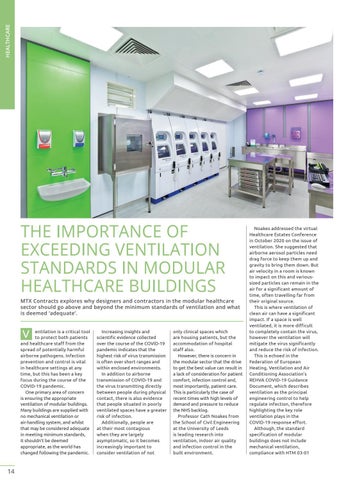HEALTHCARE
THE IMPORTANCE OF EXCEEDING VENTILATION STANDARDS IN MODULAR HEALTHCARE BUILDINGS MTX Contracts explores why designers and contractors in the modular healthcare sector should go above and beyond the minimum standards of ventilation and what is deemed ‘adequate’.
V
entilation is a critical tool to protect both patients and healthcare staff from the spread of potentially harmful airborne pathogens. Infection prevention and control is vital in healthcare settings at any time, but this has been a key focus during the course of the COVID-19 pandemic. One primary area of concern is ensuring the appropriate ventilation of modular buildings. Many buildings are supplied with no mechanical ventilation or air-handling system, and whilst that may be considered adequate in meeting minimum standards, it shouldn’t be deemed appropriate, as the world has changed following the pandemic.
14
Increasing insights and scientific evidence collected over the course of the COVID-19 pandemic indicates that the highest risk of virus transmission is often over short ranges and within enclosed environments. In addition to airborne transmission of COVID-19 and the virus transmitting directly between people during physical contact, there is also evidence that people situated in poorly ventilated spaces have a greater risk of infection. Additionally, people are at their most contagious when they are largely asymptomatic, so it becomes increasingly important to consider ventilation of not
only clinical spaces which are housing patients, but the accommodation of hospital staff also. However, there is concern in the modular sector that the drive to get the best value can result in a lack of consideration for patient comfort, infection control and, most importantly, patient care. This is particularly the case of recent times with high levels of demand and pressure to reduce the NHS backlog. Professor Cath Noakes from the School of Civil Engineering at the University of Leeds is leading research into ventilation, indoor air quality and infection control in the built environment.
Noakes addressed the virtual Healthcare Estates Conference in October 2020 on the issue of ventilation. She suggested that airborne aerosol particles need drag force to keep them up and gravity to bring them down. But air velocity in a room is known to impact on this and varioussized particles can remain in the air for a significant amount of time, often travelling far from their original source. This is where ventilation of clean air can have a significant impact. If a space is well ventilated, it is more difficult to completely contain the virus, however the ventilation will mitigate the virus significantly and reduce the risk of infection. This is echoed in the Federation of European Heating, Ventilation and Air Conditioning Association’s REHVA COVID-19 Guidance Document, which describes ventilation as the principal engineering control to help regulate infection, therefore highlighting the key role ventilation plays in the COVID-19 response effort. Although, the standard specification of modular buildings does not include mechanical ventilation, compliance with HTM 03-01














